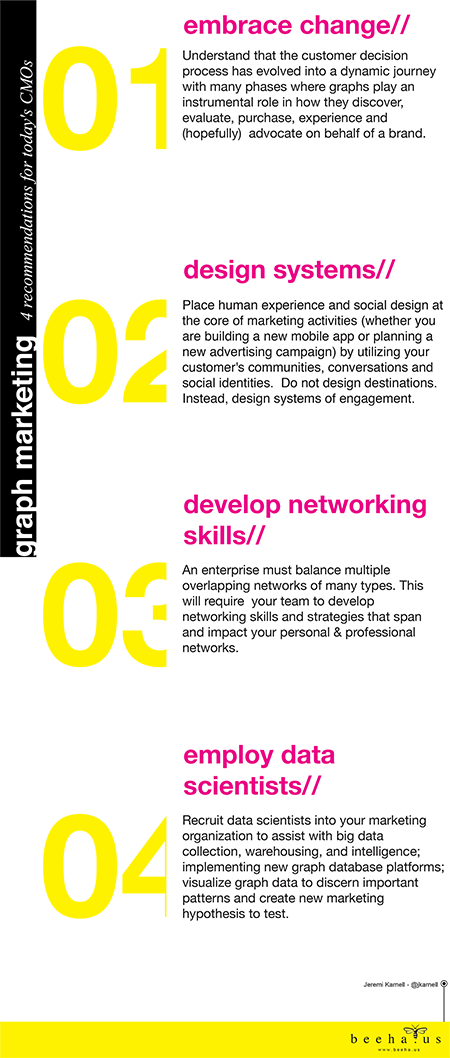
By: Jeremi Karnell, CEO
In the last two weeks, I have published a couple of posts associated with Graph Marketing. The first titled “Graph Relevance: The Rise of Graphs in Marketing & Advertising“. The next piece was an infographic that detailed the pros and cons of “Leading Graph Platforms“. Today I would like to focus on the Chief Marketing Officer (CMO) and what Graph Marketing means for them.
Universal connectivity is creating profound changes that may be felt everywhere. Within the marketing function of business, the CMO is feeling this impact most acutely in her overall strategy, product/service design, marketing/advertising, distribution/sales channels and within customer service. Indeed, just in the last couple of months, new graph innovations from Facebook, Google Twitter and LinkedIn are forcing CMOs to rethink their approaches to search marketing, social advertising, and application development.
How should CMOs respond to the above transformations? Below are four recommendations that I offer as a way to ready yourself and your organization for Graph Marketing.
1. Embrace Change
Understand that the customer decision process has evolved into a dynamic journey with many phases where graphs play an instrumental role in how they discover, evaluate, purchase, experience and (hopefully) advocate on behalf of a brand. Please read “The Funnel is DEAD!” and “Consider the Honeybee When Attracting Your Social Customers” for further context.
2. Design Systems
Place human experience and social design at the core of marketing activities (whether it’s building a new mobile app or planning a new advertising campaign) by utilizing your customer’s communities, conversations and social identities. Do not design destinations. Instead, design systems of engagement.
- Communities are defined by customer’s social relationships (Social Graphs) and shared interests (Interest Graphs). CMOs may use this data to better target and serve customers.
- Conversations refer to the interactions your customers have within their communities. Listening surfaces customer activities. Sharing provides feedback and engagement.
- Identity refers to a customers sense of self and how they are viewed by their communities. CMOs must understand how they are relevant to their customer’s social profiles.
3. Develop Networking Skills
An enterprise must balance multiple overlapping networks of many types. This will require your team to develop networking skills and strategies that span and impact your personal & professional networks.
- Know the role of different types of networks and be cognizant of the best ways to engage them.
- Enable the enterprise to interact with networks in a distributed and controlled way through a Social Media Management System (SMMS).
- Train staff with basic networking skills and in the art of improvisation to know how to engage with customers; communicate in a way that’s honest and sincere; adds value and keeps the narratives fresh and interesting.
4. Employ Data Scientists
Recruit data scientists into your marketing organization to assist with (among other things):
- Big data collection, warehousing, and intelligence.
- Emerging graph databases and benchmarks (Neo4J, Facebook’s Linkbench, etc,) and how they can be leveraged for digital applications.
- Graph data visualization to discern important patterns and create new marketing hypothesis to test.
Without question, the above four recommendations are simply scratching the surface. A book could be written about each in their own right (in fact many have already been published). If the changes that are occurring today seem overwhelming, it is because they are. You are not alone in this race to understand all of the new dynamics in marketing and communications that are at play. By simply starting with one of the above recommendations, you will put yourself and your organization on the right track and learn along the way.
Contact Us Today to learn how Graph Marketing can help your business engage your customers in meaningful ways that produce real results.



Pingback: Facebook #GraphPorn: Pepsi | Beehaus